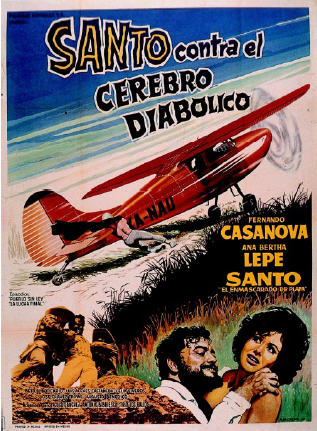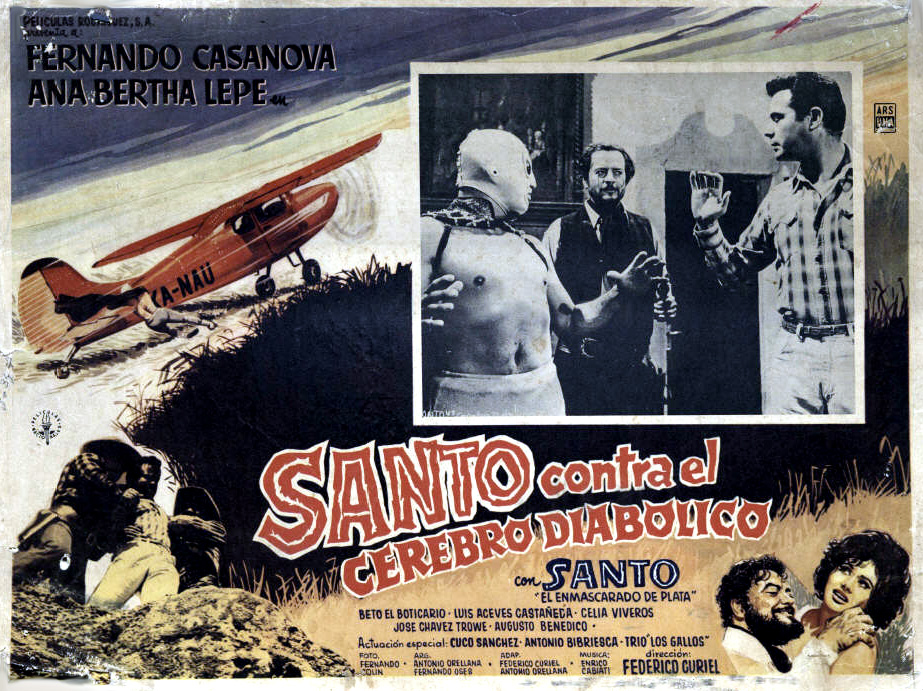
(Películas Rodríguez-Estudios América, 1961) Dir:
Federico Curiel; Scr: Federico Curiel, Antonio Orellana; Story: Antonio
Orellana, Fernando Osés; Photo: Fernando Colín; Music:
Enrico Cabiati; Songs: Federico Curiel; Prod Mgr: Luis Quintanilla Rico;
Asst Dir: Alberto Mariscal; Film Ed: J. Juan Munguía; Art Dir:
Arcadi Artis Gener; Camera Op: Raúl Rodríguez; Makeup:
Graciela Muñoz; Sound Rec: Enrique L. Rendón; Re-rec:
Félix Henkel; Union: STIC

CAST: Santo, Fernando Casanova (Fernando Lavalle), Ana Bertha Lepe (Virginia), Beto "el Boticario" [Roberto Ramírez] (Conrado), Luis Aceves Castañeda (Refugio Canales), Celia Viveros (La Jarocha, bargirl), José Chávez Trowe (Roque), Carlos Rincón Gallardo, Fernando Osés (Oriental gangster; Canales' assassin), Magda Monzón (bargirl?), José Loza (Adrián, drunk), Agusto [sic] Benedico (Santo's assistant), Víctor Velázquez (Morales, newspaper editor), Enrique Conto, Manuel Dondé (Carlos, henchman), Emilio Garibay (Renato, henchman), Cuco Sánchez (singer), Antonio Bribiesca (guitarist), Trío Los Gallos (singing trio), Manuel Vergara "Manver" (loud man in cantina), Mario Cid (henchman in car), Jesús Gómez (henchman in cabaret), Rubén Márquez (cantina man who propositions La Jarocha), Manuel "Gordo" Guevara (bartender), Juan Garza (henchman), Armando Acosta (police official at Canales' house), Vicente "Indio Cacama" Lara (henchman), Victorio Blanco ("Cocodrilo," old drunk), Nothanael León "Frankestein" (Santo's ring opponent)
Mexico City release: May 1963; 1 week run; Authorization: C (this seems a little odd, since most of Santo's movies were rated "A"--all audiences--and the content of this movie hardly seems to justify a "C," so this could be a typo)
NOTES: This is one of three Santo features made between Santo vs. los zombies and Santo vs. las mujeres vampiros, all starring Fernando Casanova and Ana Bertha Lepe, and all directed by Federico Curiel. Unseen for many years, Santo vs. el cerebro diabólico was finally released by Video Visa in Mexico in 1998 as part of its "Colosos del Ring" series.
The fact that this was a "lost" film for so long meant that plot descriptions had to be based on secondary sources, and so Emilio García Riera's Historia documental del cine mexicano contains a COMPLETELY erroneous synopsis: the film bears literally NO resemblance to the story García Riera describes. It is also rather odd to see that whoever wrote the video box blurb for Video Visa apparently didn't bother to see the film, since the same, incorrect information is repeated! The disappointing thing is that the erroneous plot sounded so good: half the film was supposedly about the "Sombra Negra" who was terrorizing a small Western town, and other half allegedly dealt with mad scientist Dr. Zuko and his monsters. However, no Sombra Negra or Dr. Zuko appear or are even referred to in Santo vs. el cerebro diabólico! Does this mean that perhaps another script existed and this was the source of the press release (or whatever García Riera used to write his description)? If so, too bad it was never made.
A further bit of mystery: the video copy runs about 79 minutes, or about 11 minutes shorter than the average América films of the era, which were composed of three "episodes." However, the print--which is quite clear and sharp--doesn't seem to have been cut (the end appears original, not abrupt), and even if it had been, 11 minutes was hardly enough time to contain a completely different story (most "episodes" ran 25-30 minutes).
Regardless, Santo vs. el cerebro diabólico isn't a bad film, even taking into account the disappointing absence of a mad scientist or mystery villain, and the fact that Santo is really used only as a sort of deus ex machina, has almost no dialogue, and displays no particular personality. The picture is filled with action, well-produced with a substantial, veteran cast and lots of extras, and features a good performance by Luis Aceves Castañeda as a lustful small-town dictator. Fernando Casanova is OK as the hero, and Ana Bertha Lepe looks good (she is introduced via a closeup of her swaying buttocks, clad in a tight skirt). One trivia note: the office of the chief of detectives is the same set used in the Neutrón films (with the odd, almost schematic map painted on one wall).
As the film opens, police agents Fernando and Conrado are pursuing a
carload of gangsters, led by a Fu Manchu-lookalike (Fernando Osés,
who later shows up in another role as one of Canales' henchmen). The
Asian villain runs into the cabaret he operates, and a wild brawl breaks
out as Fernando and Conrado try to capture him. Finally, the criminal is
captured. However, Fernando learns his girlfriend, reporter Virginia, has
defied orders and gone to Valle del Río to interview cacique
(local strongman) Refugio Canales. Fernando and Conrado take a leave of
absence from the police to track her down.

They ride into town posing as cattle buyers. When they enter the local cantina, Virginia--working undercover as a bargirl--hides from them. A drunk at the bar criticizes Canales and is about to be beaten up by Roque, one of Canales' men, when Fernando intervenes. ANOTHER brawl breaks out, with everyone in the cantina participating, even the bargirls. Suddenly, Refugio Canales enters and stops the fight. He is surprisingly pleasant to Fernando and Conrado, who take a seat with two bargirls, hoping to get a lead on Virginia's whereabouts.
Meanwhile, the suspicious hotel clerk--who works for Canales--is searching Fernando's luggage. He finds a police badge and an odd-looking wristwatch. Unknown to him, it is a radio transmitter connected to Santo's headquarters, and his puzzled comments are recorded. Santo and his associate play them back but don't know where Fernando is.
Canales is "auditioning" the new bargirl, Virginia, in the back room of the cantina. He gestures for her to raise her skirt and show her legs (she also displays a lot of cleavage when she bends over); he keeps waving "higher, higher" but they are interrupted when Carlos, the hotel clerk, bursts in with news about the two police spies.
An odd scene follows in which bargirl La Jarocha talks drunkenly to Virginia about her sad life, intercut with Cuco Sánchez singing a sad song. Virginia learns Fernando was asking about her (although she's going under a fake name, so La Jarocha doesn't realize this).
Fernando and Conrado discover their luggage has been searched, and contact Santo via radio. He says he'll help them out, right after his next wrestling bout. This match is against Nothanael León "Frankestein," who shakes his fist angrily at the jeering crowd but is rather easily dispatched in one fall by Santo.
Back in Valle del Río, two men sneak in and try to stab the sleeping Fernando and Conrado, but the police agents have put dummies in their beds. A fight ensues; Fernando is about to make one of the men talk when a knife comes in through the window and kills the henchman. In the hotel lobby, Fernando attempts to make Carlos spill the beans, but they are suddenly confronted by Roque and some of his men. Santo appears and a ANOTHER fight begins, but when Canales and the rest of his gang ride up, Fernando, Santo and Conrado escape.
Some time later, Fernando and Conrado ride back into town, crudely disguised in false beards and big putty noses, using hokey norteño accents. They are exposed when henchman Carlos spots Fernando wearing the special wristwatch. The prisoners are taken to Canales, who is curious about the purpose of the device. Conrado leans over and, speaking very distinctly, says "Señor Refugio Canales, municipal president of Valle del Río, why are you holding us prisoner in your office?" Santo hears this on the radio in his car (a convertible Mercedes sports car). In order to make them talk, Canales has his men tie cords around Fernando and Conrado's skulls; the cords are gradually tightened until the men pass out; they are revived with buckets of water, and the torture begins again. This sequence goes on for a long time and is fairly intense. Virginia bursts into the room and gasps "Fernando!" (and then tries to deny she knows him). Canales says he'll get the information he needs from her, and tells his men to throw the prisoners off a nearby cliff.
However, Santo trails them (there are some nice running inserts of Santo riding a horse) and ANOTHER brawl erupts on the edge of the cliff. During the fight, Santo throws 2 villains off the cliff to their deaths (another guy clumsily falls off, and Fernando knocks one over the edge), then punches Roque so that he tumbles over the precipice. Henchman Renato escapes to warn Canales, interrupting the villain as he is attempting to rape Virginia (another long scene, with lots of closeups of the inflamed Canales kissing and slobbering over Virginia, as she pulls his hair and pokes at his face).
Santo, Fernando and Conrado arrive at the house, but are captured at gunpoint by Renato and the rest of the gang. However, they discover Canales has fled, taking Virginia and all of their ill-gotten loot. ANOTHER brawl breaks out. Most of the action is handled by Santo, with some clowning by Conrado, but the scene is directed, shot, and edited very nicely, with a good variety of angles and some exciting music. The police (from where?) arrive to take charge. Santo, Fernando, and Conrado set off to catch Canales, who is on the way to a secret airfield with his private pilot and Virginia. Santo arrives first (he is, after all, driving a Mercedes while Fernando and Conrado are stuck in a pokey station wagon borrowed from the police); he grabs onto the airplane's tail and, wrapping his legs around a post stuck in the ground, prevents it from taking off! Fernando shows up and punches Canales. He then spanks the naughty Virginia, as Santo drives off and waves.
Santo vs. el cerebro diabólico is an entertaining film which doesn't drag (the brawls which erupt at the slightest provocation help keep things lively), but Santo fans may be a bit disappointed that the masked man doesn't play a bigger part in the plot. Still, worth watching.
Back to the Santo Filmography.
Posted 26 September 1998 by dwilt@umd.edu